|
 |
CHARTRES
|
 |
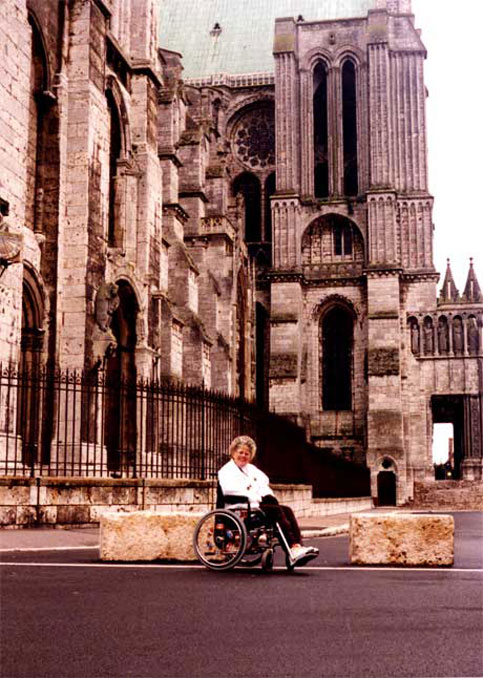
Chartres
Nan sits in front of a small portion of this great cathedral, one of the first to be built using the using the important architectural invention of the
"Flying Buttress", perhaps best seen in the Cathedral of Notre Dame.
Such construction allows much higher walls and larger windows, making the interior much more impressive and brighter. Of course, the larger windows invited more stained glass art to
be displayed, and the stained glass windows at Chartres are world famous for their beauty.
The windows are more than just as works of art. Most of the population was illiterate, and the pictures served (usually) to illustrate stories from the Bible, easily recognizable
by people who could not read.
Since the Middle Ages, kings (such as Louis XIV), queens (such as Mary Queen of Scots), and saints (such as Joan of Arc) have made a walking pilgrimage from Notre Dame in Paris to this
great Gothic cathedral in Chartres. Nancy is willing, but I am not sure it will count if she does the pilgrimage in a wheeled vehicle!
We continued south and west, into the Loire Valley, to the town of Montbazon.
We stayed overnight at a splendid 19th century chateau high on a hillside overlooking the Indre River, just a few kilometers down the road from the chateau that inspired the
story of "Sleeping Beauty".
There is a large wooded park adjacent to the chateau, and thousands and thousands of wild cyclamen fill in between the trees. Their scent is so alluring that you think you have
died and gone to Heaven. The display was so inviting I was filled with a desire to flop backwards, like making "snow angels", and just let them totally enfold me. I didn't, however, as I would not
want to hurt the flowers! |

The chateau is not wheelchair friendly, but there is a lovely gatekeeper's house, sumptuously decorated, which they used for us. It was quite spacious and just a short walk from
the chateau where meals were served in a moderately accessible dining room.
It was at this place that I captured one of my all time favorite photographs, and I want to tell you its story:
Just before daybreak, I left Nan asleep in the gatehouse and went out for a walk in the woods on the estate. As the sun came up, I was struck by the beauty of its rays filtering through
the trees. I stood in the same spot for nearly 20 minutes, while the light changed around me.
This was in the days before digital cameras, and I shot an entire roll of film. This one is my favorite. |
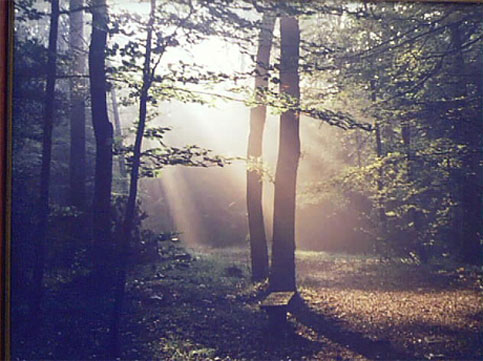
What made this so unusual- different from all other pictures I have taken of sunlight filtering through trees- is the little bench in the foreground at the base of the tree. It was
almost as though G_D had put it there and was saying to me, "Come, Nate. Sit on the bench and talk with Me awhile."
After breakfast, we left and drove to the wine country of Saint-Emilion. To this day, its famous wine is considered by many international connoisseurs to be the best in the world.
There is a most unusual monolithic church here, constructed by Benedictine Monks who dug and carved it out of solid rock. Fortunately they were not being paid by the hour for their labors,
because it took them 300 years to accomplish their task!
They topped their work with a glorious bell tower, seen here from a lower part of town: |

|
Bell tower atop Benedictine Monolithic Church, St. Emilion, France.
|
Terrain here is not wheelchair friendly. However, it is not the medieval church, not even the world's best wine that brings us here. It is the incomparable Saint-Emilion macaroons. |

|
The sign down the steep stairway says, "Fabrique de Macarons". Nan's modeling fee for this shot is 2 boxes of macaroons, at a minimum.
|
There is much more to see and do in Saint-Emilion, but the hills are too steep and the cobblestones to rough (it would be no problem with the "dune buggy"
chair). This forces us to depart earlier than we had planned. But as Nancy always says, "Something good always comes out of something bad".
We drive on 65 or 70 kilometers (35 or 40 miles) to the delightful town of Bergerac. No, it is not my family ancestral home, but it was home to Cyrano and Roxanne, hero and heroine of the
delightful play by Edmond Rostand about a man with an most elegant nose- and how he wins the love of his life.
Driving into the town, we encountered this splendid view of Bergerac lying just beyond the bridge: |
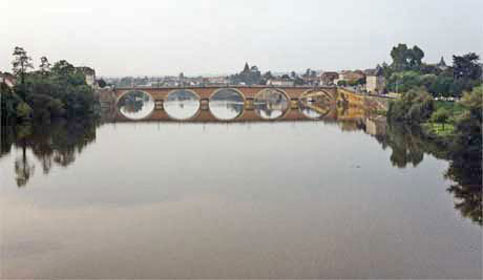
It is a typically small, narrow European town, but presented no problem to us for getting around. There was ample parking for handicapped vehicles (we carry a handicap sign with
us everywhere we go in the world. It is invaluable in helping to secure access to otherwise difficult places).
The highlight is found in the city centre, where they have erected this stature of Cyrano, featuring his elongated, upturned nose. |
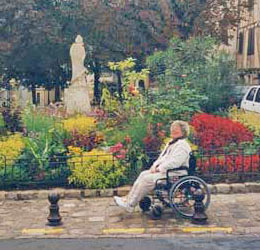
|
Nan strikes a similar pose. This would earn her a challenge to a duel from the real Cyrano!
|
When we left France, we drove south into and over the Pyrenees Mountains.
In the States, you see road signs warning about Children Crossing, Deer Crossing, Cattle Crossing. In Spain, this is what is crossing: |

This is not a real bull- it is a wooden cut-out. There are also the usual yellow signs.
Our first stop was Pamplona. Strategically located, it has a long history of military campaigns, and being conquered by the Visigoths, Franks, Moors, even Charlemagne the Great. |
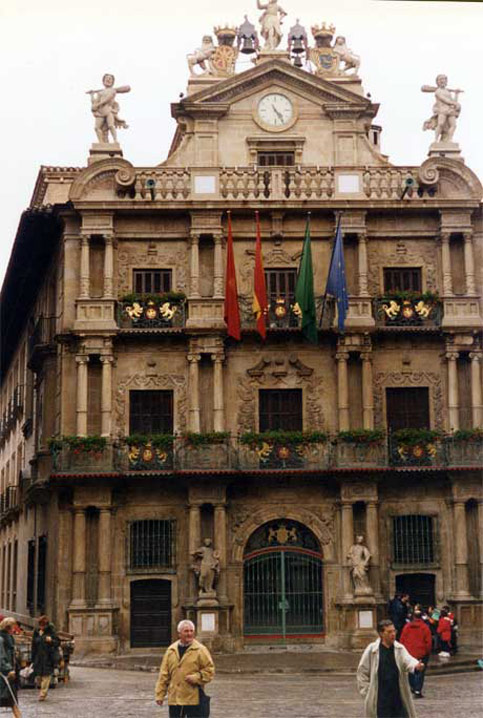
But to us, what Pamplona is about is the Festival of San Fermin, that wild party that attracted Ernest Hemingway. His classic story, The Sun Also Rises, is set in France
and Spain in the 1920's, and features a description of "The Running of the Bulls" through Pamplona's streets.
Hundreds of thousands of people line the streets, watching the bulls run from the corrals down a cordoned route to the bull ring, where they will face professional matadors later in
bull fights. The streets are quite narrow, and the thrill seekers face real danger from these bulls, which can weigh half a ton or more. |
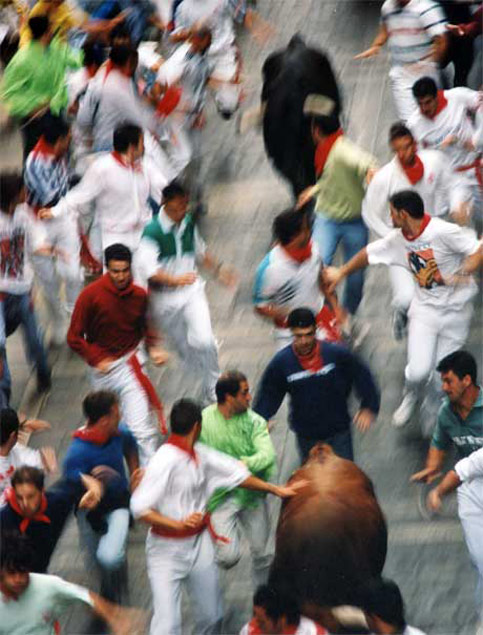
This heart stopper is not my picture. I would never get this close! During the festival, most tourists (and others of sound mind) stay safely on the sidelines
to drink, dance, and enjoy the fireworks displays.
Someone is always getting severely injured. In fact, in 1995 Pamplona made worldwide headlines when an American youngster was gored to death, the 13th runner fatally gored
since 1924. The only wonder is how come more have not died.
We continued down through Spain, passing briefly through several cities until we arrived in Seville. This city offers a multitude of things to see and do, and is a great place to explore.
As is the case in so many European cities, the cathedral is a central point of interest. The cathedral in Seville has an interesting history:
Over the original Roman foundation, the Moors built a splendid mosque with a brilliant minaret, known as "The Giralda". The Moors were conquered in 1248 AD, and a new cathedral was built
on the spot of the old mosque. The old minaret was so lovely, however, that it was not destroyed, rather was incorporated into the new cathedral. And what a cathedral! It has 5 naves and is the largest
Gothic temple in the world; it is the 3rd largest cathedral in Christendom, behind St. Peters’ in Rome and St. Peters’ in London.
The main altarpiece is the largest in the world, and took nearly 100 years to complete. |
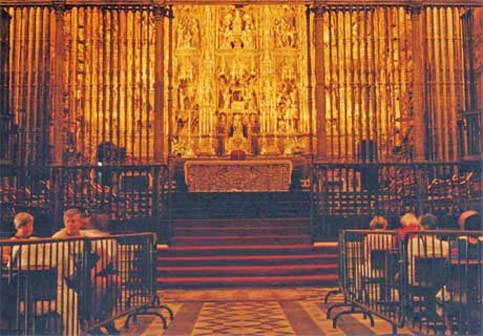
The cathedral also houses a simply stupendous pipe organ. It is frustrating that the picture is so small, as the sweep of the cathedral is so large... |
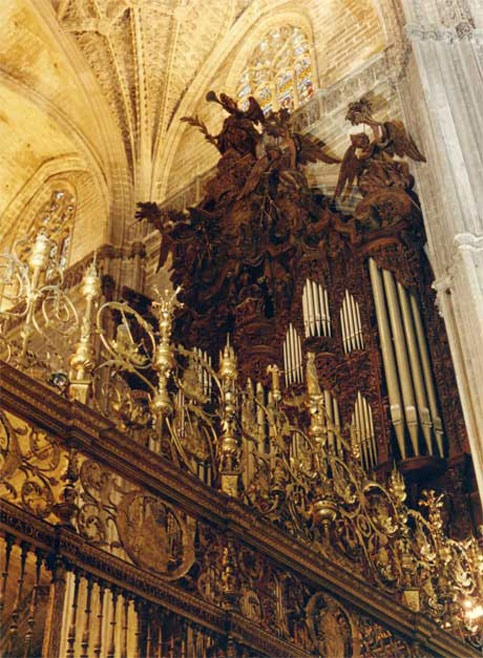
But for me, what was most captivating is that the cathedral is also home to the last remains of Christopher Columbus. If ya gotta go, this is the place to do it! |

There are 4 heralds "carrying" the coffin of Columbus. They represent the 4 Spanish reigns: Castille, Leon, Aragon and Navarre
One other story before we leave Seville and Spain:
One of the more important landmarks in Seville is the Alcazar, an Arabian style palace that dates from the 9th century AD. It is huge, but then, when the Ruler, al-Mutatid,
built it, he needed it huge, in order to house his harem of 800 women!
The grounds are difficult to navigate in a wheelchair, and were not particularly accessible when we were there. We got around anyway.
We met a most unusual couple while touring the Alcazar. They are refugees from Cuba. He lost a leg to a shark while in the water, clinging to a raft, during an escape to the US.
She has a well advanced case of multiple sclerosis. |
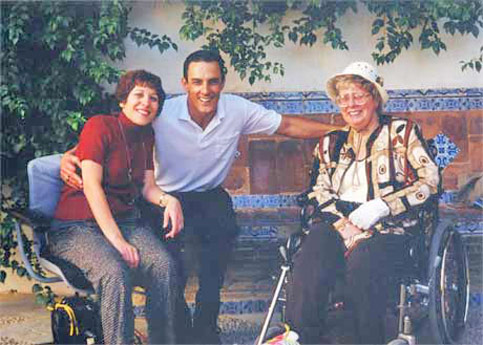
Look at their faces. You don't see any self pity or self doubts here! They have the same determination as we do. Like us, they have traveled extensively, not content to look back
on devastating events that could have severely limited their enjoyment of all life has to offer.
Got troubles? Deal with whatever is your situation and get on with it. Got problems? Focus on the solutions.
Together, the three people in this photograph represent so much courage, hope, and positive mental attitude- enough to last a small army for a lifetime! Even I, who has
seen a fair slice of adversity, was impressed...
From Seville, we went to Cordova, then Grenada, then caught a plane for the short flight across the Mediterranean to Morocco, landing in Casablanca.
The Muslims of North Africa came to Spain in 711 AD and overran the Visigoths. They established centers of wealth and culture in Cordoba, Toledo, Grenada and Seville.
Over the course of the next few centuries, the Moors were driven out of Spain, the last Moorish city, Grenada, falling to Ferdinand and Isabella in 1492 (Quite a good year for Spain).
But that was then; this is now:
Casablanca, Morocco’s business capital. And here, sitting not on a hill but on a beach on the Atlantic Ocean, is the "beacon" of Casablanca, the minaret of the great Hassan II
Mosque. |
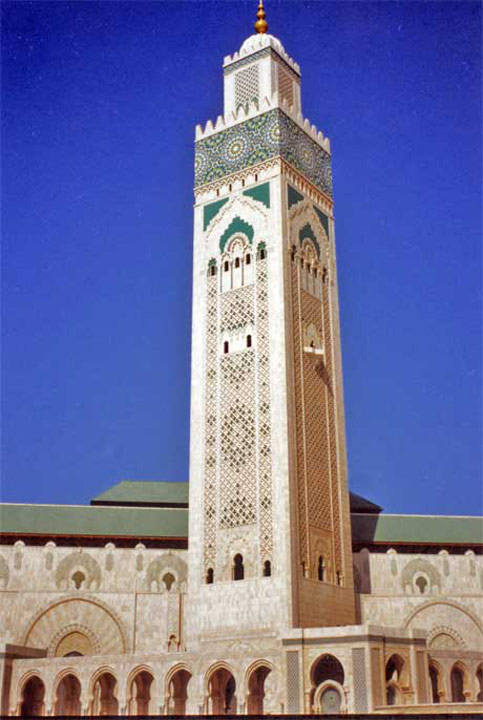
The call-to-prayer tower looms over the mosque. The artwork here is second to none in the world.
The glorious minaret and its jamour reach nearly 220 feet into the sky, making this the tallest religious building in the world. The sky is the purest blue you have ever seen.
We did not see Humphrey Bogart or Ingrid Bergman, so, after a little sightseeing, we headed off for Marrakech.
There is much of great beauty here, and also some oppressive poverty- just as is found in practically every city we have visited. But when one comes to Marrakech, it is to visit the
famed Casbah, the area of old, narrow streets surrounding the citadel.
What an intriguing place! Built around a square, Jamaâ El Fna, there is an exuberant mysticism about the area. By day, it is just a big, empty space. At night, it comes alive with
magicians, snake charmers, and sellers of all manner of strange foods.
Little alleyways radiate off the square, and you simply lose yourself wandering in and out of shops offering an abundance of exotic wares not easily duplicated in other souks around
the globe.
There are shops specializing in furniture, candles, leather goods, cotton goods; often as not, there is no shop, just an area of a sidewalk given over to a merchant for selling whatever. |
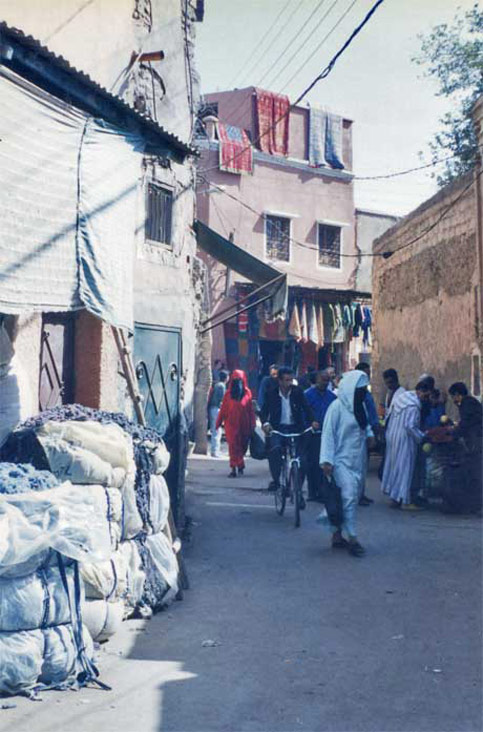
|
Cotton goods piled up as though waiting to be;loaded aboard a Mississippi riverboat in the antebellum South
|
|
Deep into the market, we came upon a most unusual fellow. Because of a congenital birth defect (or perhaps a botched delivery) His body was bent over and he could not straighten to stand
up. |

He is a maker of wooden chess pieces, fashioning these out of cedar wood on a lathe he powered with a bow in his right hand, while he steadied a chisel in his left hand, held against
the wood with his foot! We watched as he made several pieces. Then, catching us completely by surprise, he picked up one of the pieces between his toes, and offered it to Nancy from his foot.
We still have the piece, and we shall never forget him and his story. He desired not just to make a living, but to make a difference- a contribution. Under no circumstances,
he told us, would he simply beg or become a sponge on society. He was quite inspiring.
We had originally planned to stay a bit longer in Morocco, then return to Spain and tour Madrid and Barcelona. We had confirmed reservations in both cities, but to be honest, we were
exhausted and realized it was foolish to try and continue.
I arranged an earlier flight back to the US, but was totally unable to get hotel reservations overnight between the time we would arrive back in Spain and the time our flight would take
off. A real mess.
Do you recall at the beginning of our book we stated one of the reasons handicapped people don’t travel is because of a fear of change in comfortable routines?
To make a long story short, I drew on all my skills as a scoutmaster, and fashioned a sleep area for us in Madrid airport, where we over-nighted because there were no hotel rooms to
be had in the city.
I am not including a picture of our little "campsite" because I promised Nancy no one would ever see her in such circumstances!
It was an interesting night, to say the least; turned out to be one of the more interesting experiences of our travels.
There were a number of other people over-nighting with us, including a large portion of a Soviet soccer team, and a group of four nuns returning from a pilgrimage. For that one
night, all of us, total strangers to one another, became an extended family, caring for one another whenever the circumstances permitted it.
Nancy slept quite soundly until about 4:15 in the morning, when some idiot came over the loudspeaker system, turned up to full volume, and began counting in Spanish. Oh, well, our flight
was due to depart at 7:30AM anyway.
It makes for an amusing story- after the fact. While we were living it, though, it was not nearly as much fun as it sounds.
A 20-20 Hindsight analysis of the trip:
There is good reason for describing the details of this trip to you: Knowing one's limitations- and we all have them- is invaluable. If you know your limits, you can plan
for maximum accomplishment, letting you savor the "thrill of victory", while sparing you the "agony of defeat".
Were I to re-plan the trip, there are a number of things we could have done differently:
I should have been more mindful that there were too many changes of venue; too many places where we drove in late in the afternoon, unpacked, ate, and went to bed, only to arise the
next morning to eat, pack and leave.
We know now to limit our overnight hotel changes; go to one hotel, say in Rome, and use it as a base. Rent a car and drive to interesting areas to the north today,
to the south tomorrow, etc. Plan to return to the same hotel each evening.
This avoids packing and re-packing which drains so much energy. It also reduces the number of changes in routine you must make.
We also have learned to pace ourselves better, following a day of intense sightseeing with one of rest- or at least an abbreviated day of activity.
Please recall our instructions to tour guides regarding prioritizing the sights to see, starting with the most important so that if you run out of steam, you will have at least seen
the best of whatever area you are in.
We know we are particularly ill suited to hot weather. One of the things that so sapped our strength was the extreme heat of Southern Spain and Morocco. During the daytime, temperatures
in Marrakech were well over a hundred degrees. A couple of days of that simply wiped us out.
I should have inserted a day of rest at the end of activities in Morocco- a day for lazing by the pool, going into town for a movie, getting a massage, or doing absolutely nothing
at all. Yes, we know most folks want to see as much as possible and would consider such a day a waste of time. But if you are exhausted, how much are you going to enjoy yourself?
Another obvious solution would have been to schedule the trip placing Morocco first, getting there earlier by several weeks. This would have exposed us to less heat than
later in the season. Could I have discovered such information easily? Of course. I should have checked web sites that give weather information about the places we planned to visit.
As far as this actual trip is concerned, if we had reversed everything, started in Morocco and proceeded north, it would have made things easier, as accommodations are better in Europe
than they are in Northern Africa.
Recall the trouble we had trying to change our plane tickets to earlier flights, and trying to get hotel reservations in Madrid? Making any kind of change would have been immeasurably
easier in Spain than it was trying to do this from Morocco as the telecommunications in Europe are better than in Africa. This is an important thing to keep in mind when you are traveling in
the Third World.
Yes, you can say all these things are plain enough when looking in hindsight, but that begs the issue. The idea is to spare yourself as many stumbling blocks as you can. When you plan
far in advance, you have the time to go over details again and again and pick up such mistakes before they happen.
But not always!
For all my advance planning, look how many mistakes I made!
On the other hand, look at the great trip we had, in spite of the screw-ups. We were exposed to a multitude of cultures, an enormous diversity of religious thought, undeniably fantastic
art, some drop dead great shopping, wonderful cuisine, a lot of laughs and wonderful memories! That's what traveling is all about.
There is an enormous amount of information in this section, all of it, I hope, not so subtle that it will go unnoticed or unheeded. When properly researched and planned, there is
no reason why you or any physically challenged person cannot enjoy the abundance the world holds out to you! |
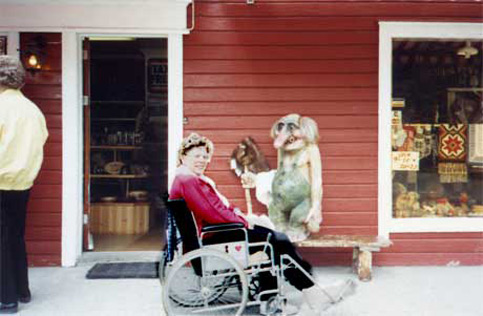 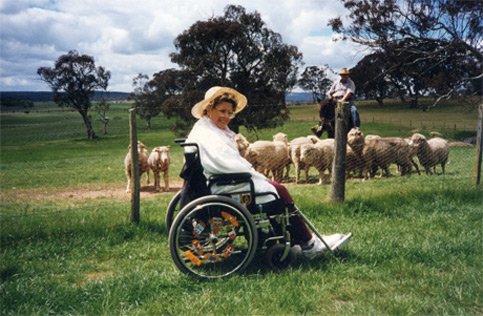
|
More friends, New Zealand1
|
|
| |
